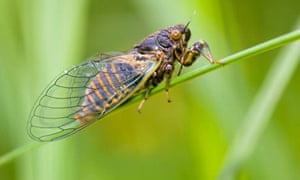More of the insects have emerged this year in NSW, Victoria and South Australia. One reason is rainfall
The buzz call of the cicada is a familiar sound of the Australian summer and this season is what David Emery calls a “super year for our summer chorusing friends”.
A veterinary immunologist at the University of Sydney and cicada expert, Emery has been monitoring the insects for decades and, along with many residents of coastal New South Wales and beyond, has registered that the volume is more ear-splitting than usual.
In NSW, Victoria and South Australia, more cicadas have emerged this summer than in recent years.
Emery says one reason is the abundance of winter and summer rainfall Australia has received.
“You often see a good emergence after drought and that may be due to plant regeneration and growth inspired by the rain,” Emery said. “After the fires, we see that regrowth as well.”
Australia is the cicada capital of the globe with more than 700 species, many of which are yet to be described.
Most of a cicada’s lifespan is spent underground, which Emery says is likely another reason the invertebrates are more abundant in some years than others.
“The last big emergence in the Blue Mountains, for example, was in 2017, and the previous ones were in 2013 and 2010.”
Many common Australian cicadas spend about six or seven years underground and when they emerge live for only a few weeks.
The female will lay eggs on a tree and die and the male, having fulfilled his lifecycle, will also die.
The eggs hatch and the nymphs fall and burrow into the ground and the cycle begins again.
The reason Australians can hear the call of cicadas for months is because different species emerge at different times.
The common “green grocer” cicadas are heard during October and November. From mid-December, they begin to be replaced by black princes, double drummers, red eyes and razor grinders.
Most of those will diminish by mid-February, Emery says, but a few solitary male princes might stick around until April.
“But the females will be gone, so they will be calling for nothing,” Emery said. “That’s always the sad part.”
NSW residents can use the Great Cicada Blitz website and the Facebook page Cicadarama to post pictures and recordings of cicadas and their locations, which Emery says could help scientists map their distribution and abundance, and describe new species.

No comments:
Post a Comment